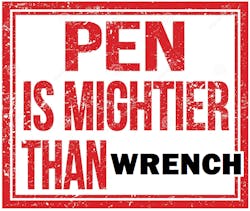What you will learn:
• Proper documentation could mean better pay for the same job
• A labor operation should exist for every task performed on a vehicle
• "Complaint/cause/correction" is the bare minimum when it comes to proper documentation
Many of us as technicians are faced with a job that isn’t so straightforward. At times, it is what occurs “between the lines” that eats up the applied time. If your service advisor/manager isn’t aware of this undocumented applied time, how can they charge or pay you appropriately?
If there is one thing I've learned (after working so many years) as a flat rate-paid dealership technician, it’s that warranty troubleshooting or electrical repair work doesn’t pay well. At least, that was my take on it in my earlier years.
Many labor operation codes exist in the warranty repair labor guides. These individual codes represent the allotted time for any specific job. Unfortunately, much of the applied time, given by the technicians is not something for which they are always compensated. For instance, for lots of the work performed there exists no labor operation for it. Often, a generic labor operation for “straight-time” can be applied, and the time invested can be documented. However, I’ve often seen claims containing this “straight-time” generic labor operation number decline. It begs the question “Why?”
After all, if the technician is performing the work necessary to complete the job properly and safely, there is no reason he or she should not get paid accordingly. It all comes down to proper documentation.
Documenting for dollars
The complaint/cause/correction is an absolute “must” but it’s what is not included in the documentation that is causing the lack of sufficient pay. Rather than stating the resulting repair in as few words as possible, try elaborating a bit more. For instance, instead of stating “repaired broken wire,” give this a try:
Left-front turn signal inoperable. Scanned DTCs and found code Bxxxxx. Through scan tool bidirectional control, commanded LF turn signal bulb “on;” bulb failed to illuminate. Removed LF turn signal lens for access, verified available voltage to LF turn signal bulb socket, terminal #1. Tested and found voltage available on the ground path circuit # xxx, at terminal #2, with LF turn signal bulb commanded “On.” Jumper ground at terminal #2, verified bulb functions normally. Tested for continuity between terminal #2 of LF turn signal bulb socket and body harness inline-connector, C128, terminal #6. The circuit was found to be “open.” Inspected and found a broken wire beneath the LF wheelhouse liner. Removed LF wheelhouse liner for access for wiring repair. Repaired wire per specified repair procedure, reinstalled LF wheelhouse liner and LF turn signal lens. Cleared DTC and verified the fix.
The example you see above was a fictional event, but it’s as real-world as you can get. Take the time to educate your service advisor on what it takes to properly test for faults, disassemble for test access, and carry out the testing, as well as repair. Even “extended road tests” can be compensated as long as a discussion occurs ahead of time and proper documentation is carried out.
About the Author
Brandon Steckler
Technical Editor | Motor Age
Brandon began his career in Northampton County Community College in Bethlehem, Pennsylvania, where he was a student of GM’s Automotive Service Educational program. In 2001, he graduated top of his class and earned the GM Leadership award for his efforts. He later began working as a technician at a Saturn dealership in Reading, Pennsylvania, where he quickly attained Master Technician status. He later transitioned to working with Hondas, where he aggressively worked to attain another Master Technician status.
Always having a passion for a full understanding of system/component functionality, he rapidly earned a reputation for deciphering strange failures at an efficient pace and became known as an information specialist among the staff and peers at the dealership. In search of new challenges, he transitioned away from the dealership and to the independent world, where he specialized in diagnostics and driveability.
Today, he is an instructor with both Carquest Technical Institute and Worldpac Training Institute. Along with beta testing for Automotive Test Solutions, he develops curriculum/submits case studies for educational purposes. Through Steckler Automotive Technical Services, LLC., Brandon also provides telephone and live technical support, as well as private training, for technicians all across the world.
Brandon holds ASE certifications A1-A9 as well as C1 (Service Consultant). He is certified as an Advanced Level Specialist in L1 (Advanced Engine Performance), L2 (Advanced Diesel Engine Performance), L3 (Hybrid/EV Specialist), L4 (ADAS) and xEV-Level 2 (Technician electrical safety).
He contributes weekly to Facebook automotive chat groups, has authored several books and classes, and truly enjoys traveling across the globe to help other technicians attain a level of understanding that will serve them well throughout their careers.

